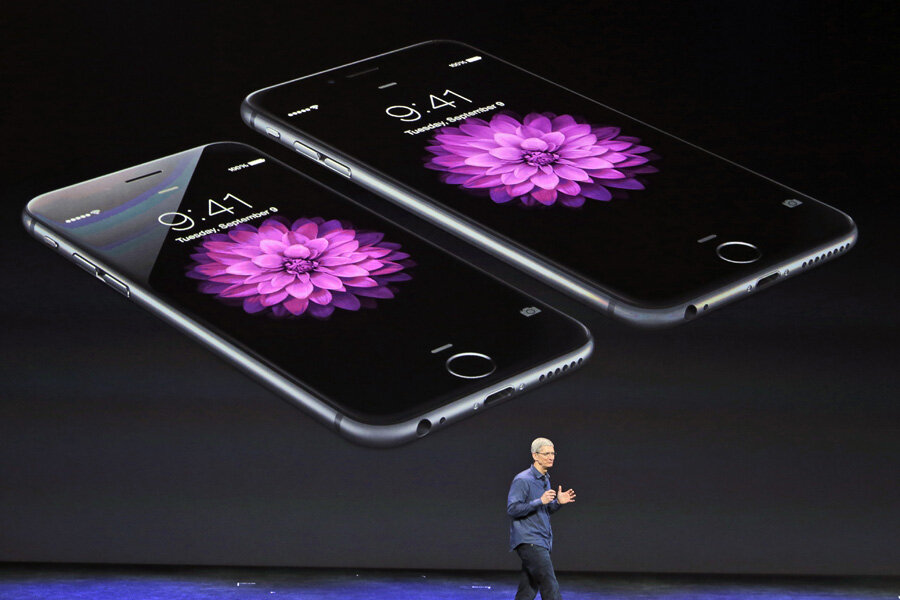How is Apple Pay different from other phone payment schemes?
Loading...
The release of Apple Pay on Monday marks the company's first foray into contactless mobile payments. The iPhone 6 and 6 Plus contain near-field communication (NFC) chips that allow users to pay for goods by tapping their phone on a pay terminal. But will it revolutionize a market that other services failed to excite?
Apple Pay has some stark differences that may compete well with other mobile payment platforms, such as Google Wallet, a similar NFC-based payment system, and LevelUp, which runs on QR codes rather than a physical chip.
Google Wallet suffers a fragmentation problem. There are more than 18,000 distinct Android devices sold worldwide, according to OpenSignal’s 2014 Android fragmentation report. Of that 18,000, only 218 are NFC-enabled phones, according to a list compiled by NFC World+, a publication dedicated to tracking developments in near-field communication.
On the other hand, Apple only has to worry about four phone models (iPhone 5S, 5C, 6, and 6 Plus), the latter two of which will be Apple Pay compatible. Going forward, it will be easier for Apple to shift consumers onto an NFC phone than for Google to convince Android-phone manufacturers worldwide to agree to include NFC on their own myriad models. Apple has a very pointed business model that may, in time, give millions of consumers the ability to pay with their phones.
But it won't be easy for Apple. The company is battling a US market that’s skeptical of the information that’s channeled through mobile payments. According to reports from Statista, 82.2 percent of mobile-phone users have never used a mobile payment system. Of the non-users, 24.7 percent are concerned about people intercepting information from their transactions.
In light of credit cards being compromised at retail stores and the recent iCloud breach that led to celebrity nude photos being leaked, Apple has a lot to address on how it protects its users’ data, especially when it comes to any accounts tied to financial institutions.
“It’s using 'tokenization' instead of putting the actual card number on the phone, which will be coupled to a unique identifier on the phone,” says James Wester, a mobile payments analyst at IDC.
Tokenization allows for payments to be authorized using a user-specific “token” rather than the credit-card number, which could be pulled and used by anyone with enough basic information about the card owner.
“They’re [also] going to use biometrics, which will make it even more secure than if you were standing there and someone had a magstripe skimmer in their hand,” Mr. Wester says.
Better user experience might help usher in a new wave of mobile payment users. If paying for your groceries by splaying your thumb on an phone screen ends up being easier than swiping, it may be worth it to switch.
“But if that wow factor isn’t enough to make people try it beyond their first time, I’m not certain that without some value for the consumer it’ll become a regular way for consumers to pay for things,” Wester says.
Forrest Whitcher, a research engineer at the Massachusetts Institute of Technology, uses Google Wallet and LevelUp on his phone, but they’re relegated to very different tasks.
“The mobile payment system I use most is LevelUp, because I can pay directly from my credit card using my phone and get discounts,” Mr. Whitcher says. If Google Wallet had similar physical terminals, he says, he’d use it more often.
Right now, Google uses Google Wallet to handle in-application payments across Android apps. Paying for an Uber drive and buying apps, for instance, would be handled through Wallet. But Google Wallet doesn’t have the distribution of physical terminals that power LevelUp, a service that’s focused on local businesses.
LevelUp provides customers with initial discounts for trying out a new business and more discounts, ranging from $1 to $5, when they reach milestones as repeat customers.
“Since we speculated that Apple was going to enter the mobile payments field, we’ve been extremely excited,” says Crystalyn Calderón, marketing manager at LevelUp. “If there’s any company that has the clout to put it to the forefront, it’s Apple.”
Like Apple Pay, LevelUp uses tokenization to conceal the user’s credit card number, Ms. Calderón says. However, it isn’t foolproof: Users’ QR codes can still be captured during the transaction.
While Apple Pay may succeed as a user-friendly mobile payment method and reach far more consumers than platforms that aren’t bundled on every phone, it might want to take some notes from other companies to make it much more than a parlor trick.







